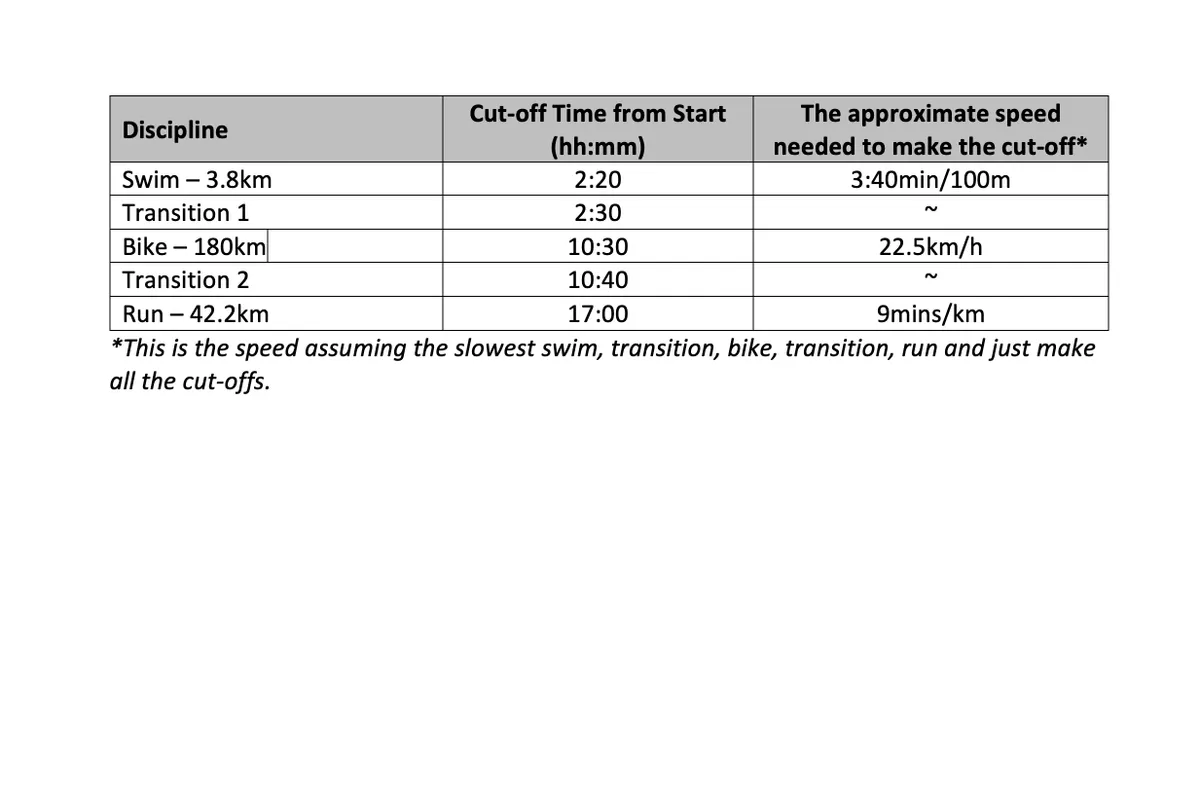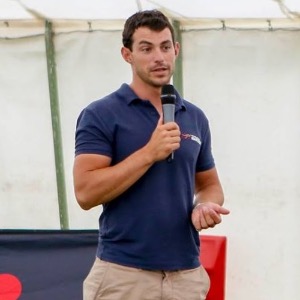As the catchphrase goes: “Anything is possible”, but is it possible to train for an Ironman in only one year? It certainly depends on your starting point, but a year seems like a reasonable amount of time to prepare for an Ironman. Let’s look at some considerations before you commit since ultimately, the question is not “can you”, but “should you?”
What is the bare minimum performance level that you need to finish an Ironman triathlon?

The times above are your absolutes; if you are to make the final cut off, you have to hit all these along the way. The question is, where do you sit on those ranges? What are you currently capable of? You may come from a running background and can run a marathon in 4 hours easily, but if you can’t ride fast enough to make the 10:30 cut-off, you won’t take one step on the run course!
This table gives us a good yardstick to see how plausible an Ironman is, and what you need to do to get to that finish line. Most people focus on the peak speeds to get around quickly. The reality is, it is best to consider what factors would reduce your chances of success and mitigate them. So, what are the critical considerations for the different disciplines?
Swim
For many people, the swim is the significant hurdle. 3.8km is a long way, and in a relatively foreign environment – no one spends all their time in the water. You need to be able to swim, it sounds obvious, but it is critical to your Ironman success.
Although you cannot win a race from the swim, a long time in the water will have a detrimental effect on your performance in the following disciplines. You cannot consume fluids and fuel on the swim, so the longer you take, the more depleted you will be for the start of the bike and then the run.
Additionally, more time in the water will mean you will be more tired from the effort of swimming, as well as getting colder. Both of which will mean increased energy consumption. Any time you can save here will help you later in the day.
- Can you swim breaststroke in an Ironman?
- Do I need to adapt my front crawl swim stroke for Ironman?
- How to train and prepare for your first Ironman swim
Bike
Again, critically, you need to be able to ride a bike! A bike is essential for anyone signing up for an Ironman.
However, you don’t want to be aggressively aerodynamic (many aerodynamic speed gains are measured at 40km/h, which is certainly faster than most people race over long-course). You should consider that the longer you are out, the more significant time savings can be had due to the time you spend on the bike, rather than the absolute speed and aerodynamic gains.
Aside from being “aero”, the fit is vital for comfort; if you are on the course for longer, you need to ensure you are comfortable. This also adds to your confidence and will help you in all the training sessions too. No one wants to spend 30 mins, let alone seven hours, on an uncomfortable bike. You are more likely to complete (and enjoy) the training if you are comfortable.
Having confidence in your bike means you can take a swig from a water bottle and take your hands off to fuel as you go past aid stations, which will keep you moving on the course.
Ultimately, confidence on the bike means you don’t slow down (or even stop) as much for aid stations fuelling, cornering, descents, all of which allows you to hold a higher average speed, making it more likely that you can make the cut-off and enjoy the run.
- How much bike training do you need to do for an Ironman?
- Can I do an Ironman in trainers and flat pedals?
Run
The run can be thought of as “whatever it takes”. If you get to race day, then anything goes to get to the finish line. In fact, the rules state that the permitted forms of locomotion as: “run, walk or crawl”. But in preparing for an event, running has the highest risk of injury, which could lead to a DNF (did not finish) or, worse, a DNS (did not start). Therefore, avoiding injury through training is a critical component of your success on race day.
If you have a good enough swim and bike, you can look at the marathon as a very long run/walk or even a trek. We see people struggling to make this cut-off most frequently because they run out of time. They can go the distance but not within the cut-off. Therefore, don’t look at the aforementioned pace of 9min/km in isolation, since this final leg comes after a very long day of exercise and energy depletion.
- How can I increase my run mileage and volume safely, without getting injured?
- Ironman run training: how important is the weekly long run?
How do you start training for an Ironman?
Training for an Ironman is well documented, and there are many more plans than there are events to sign up to. We won’t cover the methods now, but considering that most programs last from 16-40 weeks, we can be confident that it leaves us scope to getting fit enough within a year.
- Free 12 month Ironman training plan
- Free 12-week Ironman build-phase training plan
- Free 3 month Ironman base training plan
- 12-week Ironman peak-phase training plan
- Free 12-week Ironman training plan
- Free 6 month Ironman base training plan
We need to look beyond the plan and ensure we are fit enough to start the training programme. That may take a little longer if your plan begins with two swims, four bikes and three runs every week, than if it consisted of just one of each discipline. Ultimately, you must build the training to get to the start of your training plan.
An excellent way to look at it is that the beginning of your training plan should be your typical training week. Failing to be at the required fitness for the start of the program will mean a jump in training, increasing the likelihood of breaking or burning out later when the load becomes too much.
The sport of Ironman takes up a lot of time. Training becomes a big part of your priorities, and so the ability to train for this distance within a year will be largely down to your available time. You need to find the space in your week to do some long bike rides, swims and runs, and recover from them. Often, new athletes think this can be solved by sleeping less, but this can be a dangerous precedent and result in burning out later.
Make sure you also allow for 8 hours of sleep. If you haven’t got that available time, then realistically, you cannot train for an Ironman. Consider the logistics over the whole year and in particular 2-3 months before your race as that will be the time you are training the most. You could compare that with your training plan and see if you do have the available time.
- Why is sleep important for athletes?
- How does alcohol affect your sleep?
- 5 foods that... will help aid sleep
Finally, consider the psychology of the sport. Ironman training is as much about the training mindset as it is about the race day mindset. You are asking a lot of yourself on race day, and a long-term commitment over the year, through sun or rain. Are you ready for that commitment, and if you aren’t sure, what can you do to help facilitate that training mindset?
You might see that we have started backwards: defining what an Ironman will take, looking for the minimum requirements to get there, finding a training plan, and ensuing we are fit enough to build the training plan. This reverse engineering is an excellent way to ensure you create manageable steps into your Ironman adventure.
When you can visualise the steps, you can decide whether you can (or should) do an Ironman within a year. If you aren’t sure, then there is no harm in looking at it as a two-year project and begin with some other distance triathlons. Either way, you want to be in a position that you enjoy the journey as much as the finish line.
Philip Hatzis is a BTF Level 3 qualified coach and Ironman certified coach. He is the founder and head coach of Tri Training Harder.
Philip Hatzis has taken many of his coached athletes to World and European Championships in all distances, including both Ironman and ITU, to both medal and compete. As an athlete he has competed at the Ironman World Championships in Kona.
Photo by Pablo Blazquez Dominguez, from Getty Images for IRONMAN
